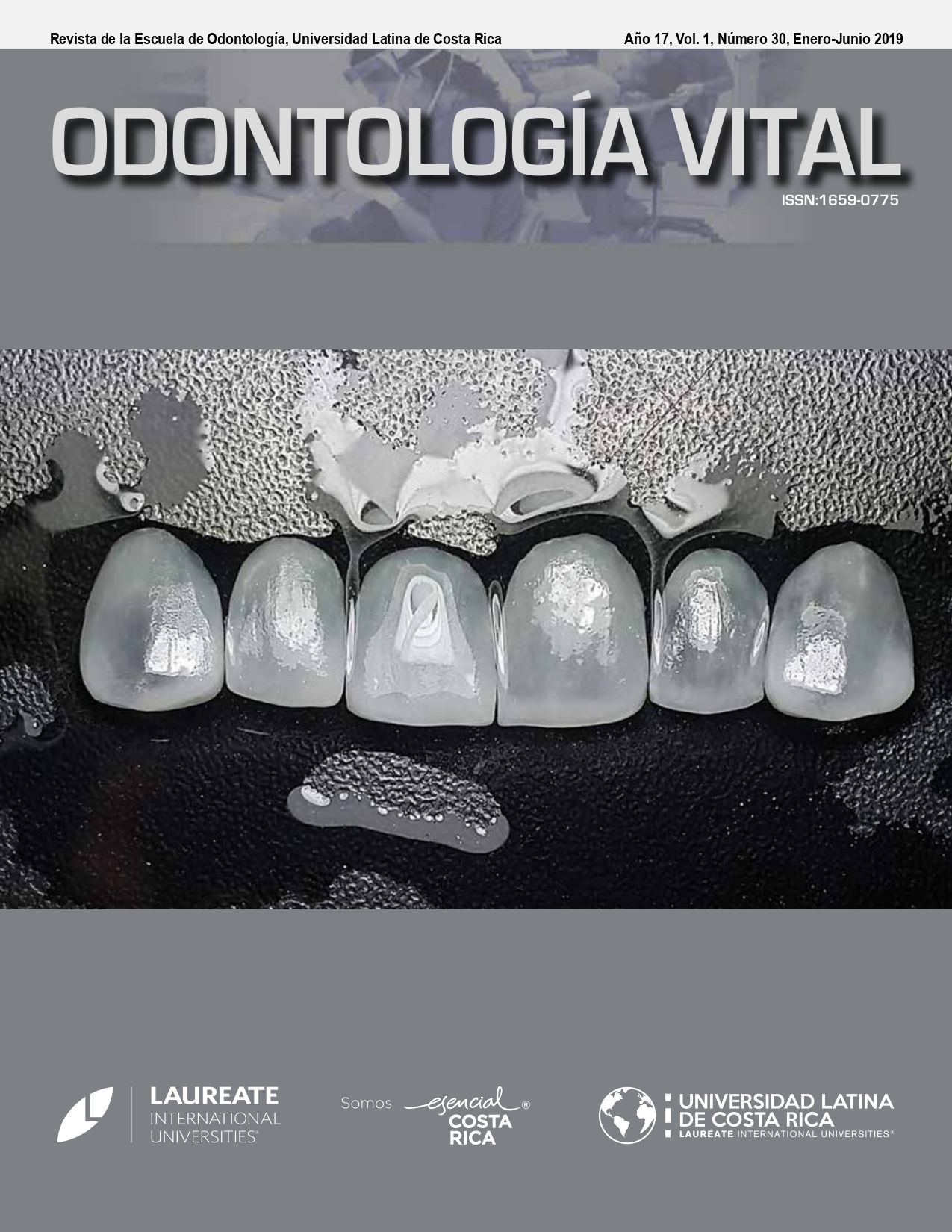In vitro Comparison of the adhesive strength of the etch and rinse adhesive systems and self etching
DOI:
https://doi.org/10.59334/ROV.v1i30.135Keywords:
Adhesive strength, adhesion to enamel, adhesives. (DeSC)Abstract
The purpose of the study was to compare in vitro the adhesive strength of the Etch and Rinse systems of the 4th and 5th generation; and Self Etch systems of the 6th and 7th generation. A descriptive, comparative study was carried out. Twenty third molars were used for this study, (these molars were extracted for orthodontic and prophylactic purposes). Each teeth were cut into two pieces obtaining 40 pieces in total, then they were chosen randomly of which 10 pieces were cut with the 4th generation adhesive strength, 10 with the 5th generation, 10 with the 6th generation and 10th with the 7th generation of the adhesive. A vertical traction test was performed, measured in kilograms force, and then transformed into megapascals (Mpa).
The 4th generation resins obtained an adhesive resistance of 29.9 Mpa, the 5th generation resins obtained a resistance of 16.9 Mpa, the 6th generation obtained a resistance of 27.5 Mpa and the 7th generation obtained a resistance of 11.0 Mpa. The results were subjected to normality tests using the Shapiro Wilk test. These results were analyzed using the oneway ANOVA, finding statistically significant differences between the four study groups with a p-value of 0.001. As a conclusion; the 4th generation adhesive system classified as Etch and Rinse showed better adhesive strength, followed by the 6th generation adhesive system classified as Self Etch.
Downloads
References
Correa, B., & Andrés, N. (2011). Resistencia adhesiva de restauraciones de resina compuesta sobre bases de ionómero vítreo sometidas a dos tratamientos acondicionadores distintos. Repositorio Académico - Universidad de Chile. Recuperado a partir de http://repositorio.uchile.cl/handle/2250/133452
Cosio, H., Abanto, M., & Lazo, L. (2016). Estudio in vitro de la resistencia adhesiva a dentina de dos resinas fluidas para restauración. Ciencia y Desarrollo, 19(2), 13-18. https://doi.org/10.21503/cyd.v19i2.1297
Garrido González, R. (2008). Estudio comparativo in vitro de la resistencia adhesiva de resina compuesta sobre dos diferentes orientaciones de los túbulos dentinarios. Repositorio Académico - Universidad de Chile. Recuperado a partir de http://repositorio.uchile.cl/handle/2250/137866
Maldonado Araya, F. A. (2014). Análisis comparativo in vitro de la resistencia adhesiva de restauraciones de resina compuesta utilizando el adhesivo Peak® Universal Bond con y sin grabado ácido previo de superficie. Universidad de Chile. Recuperado a partir de http://repositorio.uchile.cl/handle/2250/130510
Meza Juárez, M. L. (2016). Comparación in vitro de la resistencia adhesiva de un cemento autoadhesivo con diferentes tipos de tratamientos previos a la superficie dentinaria.
Moncada, G., Vildósola, P., Fernandez, E., Estay, J., Junior, de O., B, O., … Martin, J. (2015). INCREASED LONGEVITY OF RESINS BASED COMPOSITE RESTORATIONS AND THEIR ADHESIVE BOND. A LITERATURE REVIEW. Revista Facultad de Odontología Universidad de Antioquia, 27(1), 127-153. https://doi.org/10.17533/udea.rfo.v27n1a7
Monsalves Bravo, S. I., Terrazas Soto, P., Toro Urbina, G., & Bader Mattar, M. (2014). Evaluación del grado de sellado marginal y resistencia adhesiva de restauraciones de resina compuesta con adhesivo convencional en dentición primaria y definitiva. Revista Clínica de Periodoncia, Implantología y Rehabilitación Oral, 7(3), 149-156. https://doi.org/10.1016/j.piro.2014.09.001
Phillips’ Science of Dental Materials - 12th Edition. (s. f.). Recuperado 21 de febrero de 2018, a partir de https://www.elsevier.com/books/phillips-science-of-dental-materials/anusavice/978-1-4377-2418-9
Downloads
Published
Issue
Section
License
Copyright (c) 2019 Hildrex Evans Vargas Robles, Elvis Efraín Miranda Cordova, Liceth Lazo Otazú, Herbert Cosio Dueñas

This work is licensed under a Creative Commons Attribution 4.0 International License.
Authors who publish with Odontología Vital agree to the following terms:
- Authors retain the copyright and grant Universidad Latina de Costa Rica the right of first publication, with the work simultaneously licensed under a Creative Commons Attribution 4.0 International license (CC BY 4.0) that allows others to share the work with an acknowledgement of the work's authorship and initial publication in this journal.
- Authors are able to enter into separate, additional contractual arrangements for the non-exclusive distribution of the Odontología Vital's published version of the work (e.g., post it to an institutional repository or publish it in a book), with an acknowledgement of its initial publication.
- Authors are permitted and encouraged to post their work online (e.g., in institutional repositories or on their website) prior to and during the submission process, as it can lead to productive exchanges, as well as earlier and greater citation of published work.







